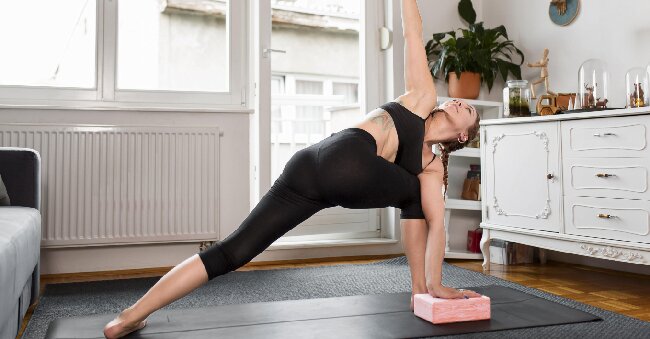
10 Innovative Ways to Use Yoga Bricks: Maximize Your Yoga Routine
Looking to enhance a yoga practice and bring it to a higher level? Yoga bricks could be a great addition to a routine.
The various types of yoga bricks available, ways to include them in practice, and creative uses for daily life are explored.
Enhancing balance in arm balances and offering lumbar support in bed are some of the benefits yoga bricks provide for yogis at different levels. Let’s explore how a yoga routine can be optimized with the help of these versatile props.
What Are Yoga Bricks?
Yoga bricks are commonly used props in yoga practice to offer support, stability, and alignment during various asanas and postures. These blocks, typically constructed from foam, cork, or wood, are aids for practitioners at all levels to enhance their practice and improve posture.
Incorporating yoga bricks into a routine can help improve flexibility, strength, and stability, enabling individuals to explore poses safely and effectively. Whether someone is a beginner aiming to achieve proper alignment or an experienced yogi seeking to refine form, these props provide valuable assistance in reaching full potential on the mat.
Why Incorporate Yoga Bricks into Your Practice?
Utilizing yoga bricks in your practice can enhance your flexibility, strength, and stability by offering essential support and alignment during challenging postures and asanas. These versatile props not only assist in achieving deeper stretches but also enable you to maintain poses for longer periods comfortably.
By incorporating yoga bricks, you can progressively develop your strength and balance, enabling you to safely explore a broader range of movements. The assistance provided can also aid in injury prevention by reducing strain on joints and muscles, promoting a more mindful and focused practice.
Yoga bricks can be utilized as tools for modifications, making poses achievable for practitioners at all levels and enhancing the overall yoga practice experience.
What Are the Different Types of Yoga Bricks?
There are three main types of yoga bricks available: foam, cork, and wooden, each offering unique characteristics and benefits for yoga practitioners.
Foam yoga bricks are lightweight and provide cushioning, making them ideal for beginners or individuals with sensitive joints. They are also durable and easy to clean.
Cork yoga bricks are eco-friendly, firm, and offer excellent stability, making them suitable for advanced practitioners looking for more support in challenging poses.
On the other hand, wooden yoga bricks are sturdy and provide a firm foundation, perfect for maintaining alignment in standing poses.
Choosing the right yoga brick can greatly enhance your practice by improving poses, alignment, and stability.
1. Foam Yoga Bricks
Foam yoga bricks are commonly used props in yoga practice known for being lightweight, supportive, and comfortable. They are utilized to offer gentle support and cushioning during various yoga poses.
Due to their lightweight nature, foam yoga bricks are easy to carry to and from the yoga studio, allowing practitioners to seamlessly incorporate them into their practice. The supportive properties of these bricks assist in achieving proper alignment, which can be particularly beneficial for beginners or those focusing on enhancing flexibility and balance.
Plus enhancing stability during challenging poses, foam yoga bricks also provide a soft surface that reduces pressure on joints, thus making yoga practice more accessible and enjoyable. The cushioning provided by the foam bricks ensures comfort during seated or reclining postures, encouraging relaxation and concentration in each pose.
2. Cork Yoga Bricks
Cork yoga bricks are eco-friendly, sustainable, and durable props that offer natural texture, firm support, and stability in various yoga postures. These environmentally conscious yoga accessories are crafted from renewable cork material, making them a perfect choice for yogis seeking sustainable alternatives.
Their sturdy construction provides a reliable foundation for practitioners during balancing poses, ensuring stability and safety in their practice. The natural texture of cork offers a comfortable yet non-slip surface for enhanced grip and traction. Their long-lasting quality means that yogis can rely on these bricks for years to come, reducing the need for frequent replacements and minimizing waste.
3. Wooden Yoga Bricks
Wooden yoga bricks are traditional, firm, and stable props that provide a solid foundation and support for yoga practitioners, especially in challenging poses.
The natural material of wooden yoga bricks offers a sense of groundedness and connection to the earth, enhancing balance and stability during practices. The firmness of these bricks helps in maintaining proper alignment in various yoga poses, promoting better posture and reducing the risk of injury. Their stability allows yogis to deepen their stretches and poses with confidence, knowing that they have reliable support beneath them.
Wooden yoga bricks are essential tools for yogis seeking a strong and steady practice foundation.
How to Use Yoga Bricks in Your Practice?
Yoga bricks can be used to enhance one’s practice by offering support for standing poses, increasing flexibility in forward bends, improving balance in arm balances, enhancing hip opening poses, and deepening twisting postures.
Incorporating yoga bricks into a routine can help achieve optimal alignment in challenging postures such as inversions and backbends. These props are especially useful for beginners or those with limited flexibility, allowing them to modify poses to match their current abilities.
By using yoga bricks, individuals can gradually enhance strength and stability with the necessary assistance to delve deeper into their practice. It’s important to adjust the placement and height of the bricks to accommodate personal needs and comfort levels for a safe and effective yoga session.
1. Support for Standing Poses
When using yoga bricks for support in standing poses, ensure proper alignment and stability by placing the bricks at the desired height to assist in maintaining balance and correct posture. This alignment is crucial to prevent strain on the joints and muscles, making the practice more effective and sustainable over time. By using the bricks strategically, one can gradually work towards deeper stretches and poses, enhancing flexibility and strength.
Remember to engage the core and ground through the feet to find stability in each pose, allowing the bricks to provide support while focusing on alignment and breath. Utilizing yoga bricks in this way can help progress in the practice and deepen understanding of posture and stability.
2. Increase Flexibility in Forward Bends
Improve flexibility in forward bends by incorporating yoga bricks to help deepen the stretch gradually, providing an alternative method for individuals who may find it challenging to reach the floor comfortably.
By integrating yoga bricks into your routine, you introduce new opportunities for enhancing flexibility. These blocks offer a sturdy base, allowing you to ease into the position and progress slowly according to your comfort level. Whether you’re a novice or an experienced yogi, using props like yoga bricks can assist in refining your alignment and reducing the risk of strain or injury.
The additional support from the blocks helps in maintaining proper posture, ensuring a safer and more efficient stretch. By including props such as yoga bricks, you can elevate your overall yoga practice by increasing accessibility and inclusivity for practitioners of all skill levels.
3. Improve Balance in Arm Balances
The balance in arm balances can be challenged by incorporating yoga bricks to offer extra stability and support, allowing practitioners to attempt challenging poses confidently.
Yoga bricks are versatile props that can be strategically utilized to enhance the practice of arm balances. These props help individuals modify their positioning, improve proprioception, and refine alignment to enhance stability and minimize injury risks. This innovative technique enhances the yoga experience and enables practitioners to develop strength, flexibility, and control gradually, facilitating progress towards advanced arm balance variations.
4. Enhance Hip Opening Poses
Hip opening poses can be modified and enhanced using yoga bricks to provide extra support and variation. This allows practitioners to deepen their stretches and improve alignment in poses that focus on the hips.
Yoga bricks are useful props for individuals looking to maximize the benefits of hip opening poses. By using these versatile tools, practitioners can tailor their practice to meet their specific needs and abilities.
Strategically placing yoga bricks can offer stability and assistance, helping practitioners ease into challenging poses and explore greater flexibility in their stretches. By utilizing yoga bricks, practitioners can experiment with various arrangements and modifications, fostering a sense of curiosity and exploration in their yoga practice.
5. Deepen Twisting Poses
Enhance your twisting poses by adding yoga bricks to improve grip, stability, and core strength. This can enable a more controlled and balanced rotation in poses that focus on spinal mobility.
Strategically using yoga bricks in twisting poses can enhance your ability to maintain proper alignment and depth while reducing the risk of strain or injury. For instance, placing a brick against the outer elbow during a seated twist can help you engage your core more effectively and achieve a deeper rotation. By pressing into the brick, you can increase oblique engagement, deepen the twist, and attain a more significant stretch, enhancing spinal flexibility.
Innovative Uses of Yoga Bricks in Daily Life
Discover alternative uses for yoga bricks outside of the yoga studio, such as utilizing them as support for office chairs, lumbar cushions in bed, foot stretchers, props for headstands, and aids for meditation to enhance comfort and relaxation.
Incorporating yoga bricks into daily routines can involve placing them under feet while seated at a desk to relieve pressure and enhance posture. They can also serve as makeshift bookends on a nightstand to add a decorative element while promoting better alignment for sleep. Their versatility extends to being used as doorstops or plant pot risers, bringing a sense of tranquility to living spaces while enjoying their ergonomic advantages.
1. Office Chair Support
Utilize yoga bricks as ergonomic support for office chairs to enhance comfort, improve posture, and maintain proper spinal alignment during extended periods of seated work.
These adaptable props can be strategically positioned under your feet or behind your lower back to offer extra support and promote a more neutral spine alignment. By elevating your feet slightly, yoga bricks can help reduce pressure on the lower back and boost blood circulation.
Incorporating yoga bricks in this manner can help prevent slouching, encourage an upright posture, and lessen strain on your neck and shoulders. Experiment with various placements to determine the most comfortable and supportive position for your individual body alignment.
2. Lumbar Support in Bed
Improve lumbar support in bed by using yoga bricks as cushions to offer relaxation, support, and alignment for the lower back, which can lead to better sleep quality and spinal health.
By adding yoga bricks to your bedtime routine, you may notice a significant enhancement in sleep comfort and overall well-being. These blocks help alleviate pressure on the lumbar region, enabling the muscles to relax and the spine to align naturally. This not only reduces discomfort but also fosters a rejuvenating effect on the lower back, which can greatly improve your quality of rest.
With the additional support and stability from the yoga bricks, you can establish a more optimal sleeping environment tailored to your specific requirements, ultimately resulting in a revitalized and refreshed feeling upon waking.
3. Foot Stretcher
Yoga bricks can be repurposed as foot stretchers to increase flexibility, support foot health, and relieve foot and arch tension, providing a rejuvenating experience for weary feet. By utilizing yoga bricks for foot stretching, individuals can effectively target specific areas in their feet, helping to stretch and release tight muscles, enhancing overall flexibility. This practice can be especially beneficial for those who spend extended periods on their feet or experience foot-related problems.
Employing yoga bricks for foot stretching not only helps in easing tension and discomfort but also aids in enhancing circulation and lowering the likelihood of common foot issues. The gentle pressure from the bricks offers a comforting massage effect, delivering a revitalizing feeling at the end of a long day.
4. Headstand Prop
Yoga bricks can be used as supportive props for headstands to improve stability, balance, and confidence in inversions, allowing practitioners to safely explore the benefits of this advanced yoga pose.
By incorporating yoga bricks into headstand practice, a stable foundation is created to support body weight, reducing strain on the neck and shoulders. This added support not only enables holding the headstand longer but also helps in finding proper alignment, promoting a safer and more aligned inversion experience.
Experimenting with different headstand variations, such as tripod headstand or wide-legged headstand, and strategically using the bricks can deepen the practice while maintaining a sense of security and control.
5. Meditation Support
A serene meditation space can be created by using yoga bricks for support during seated practices. This can help in fostering a focused and tranquil environment for mindfulness and inner peace.
Incorporating yoga bricks into a meditation routine can significantly enhance the experience by providing stable and adjustable support for various seated postures. These bricks aid in maintaining proper alignment, reducing muscle strain, and allowing for deep relaxation during meditation practice.
Elevating the hips or supporting the knees with yoga bricks can lead to a greater sense of comfort, encouraging longer and more focused meditation sessions. This enhanced comfort can help in creating a peaceful and mindful atmosphere, allowing individuals to fully engage in the present moment.
How to Choose the Right Yoga Brick for You?
Choosing the right yoga brick involves considering factors such as support level, comfort, material variation, and alignment benefits to align with individual practice needs and preferences.
For optimal support, selecting a yoga brick with varying levels of density can offer the stability required during different poses. Comfort plays a crucial role, so opting for a brick with smooth edges and a size that fits hands comfortably can enhance the overall experience. Different material options like cork, foam, or bamboo provide varied textures and weights, allowing individuals to choose one that matches their personal preferences. Prioritizing alignment benefits ensures that the brick assists in maintaining proper posture and alignment during practice sessions.




No Comments